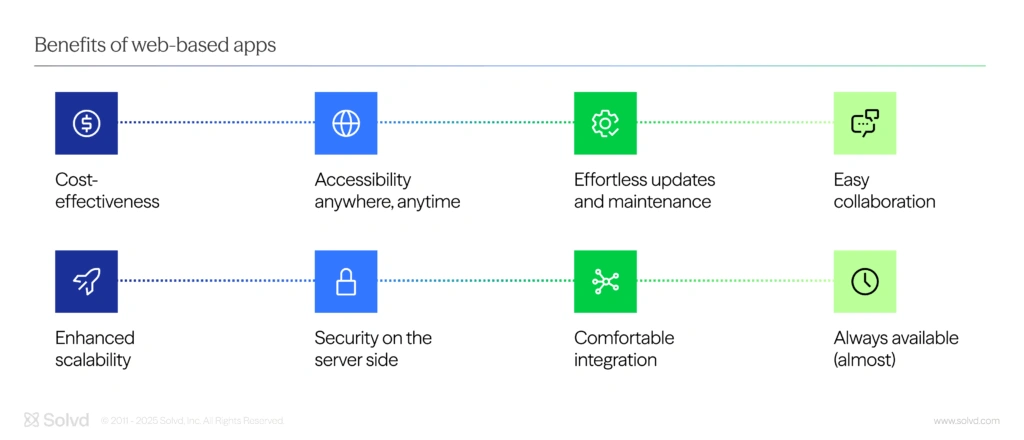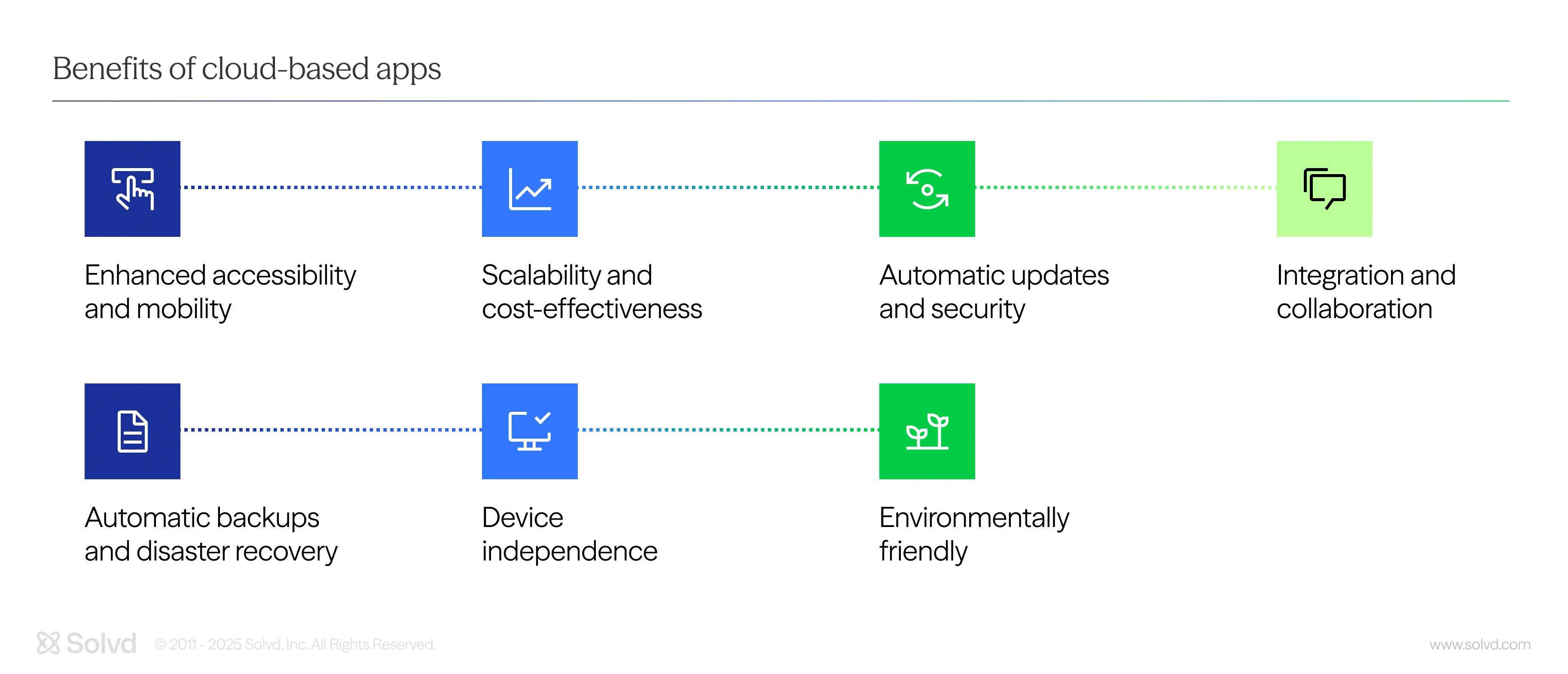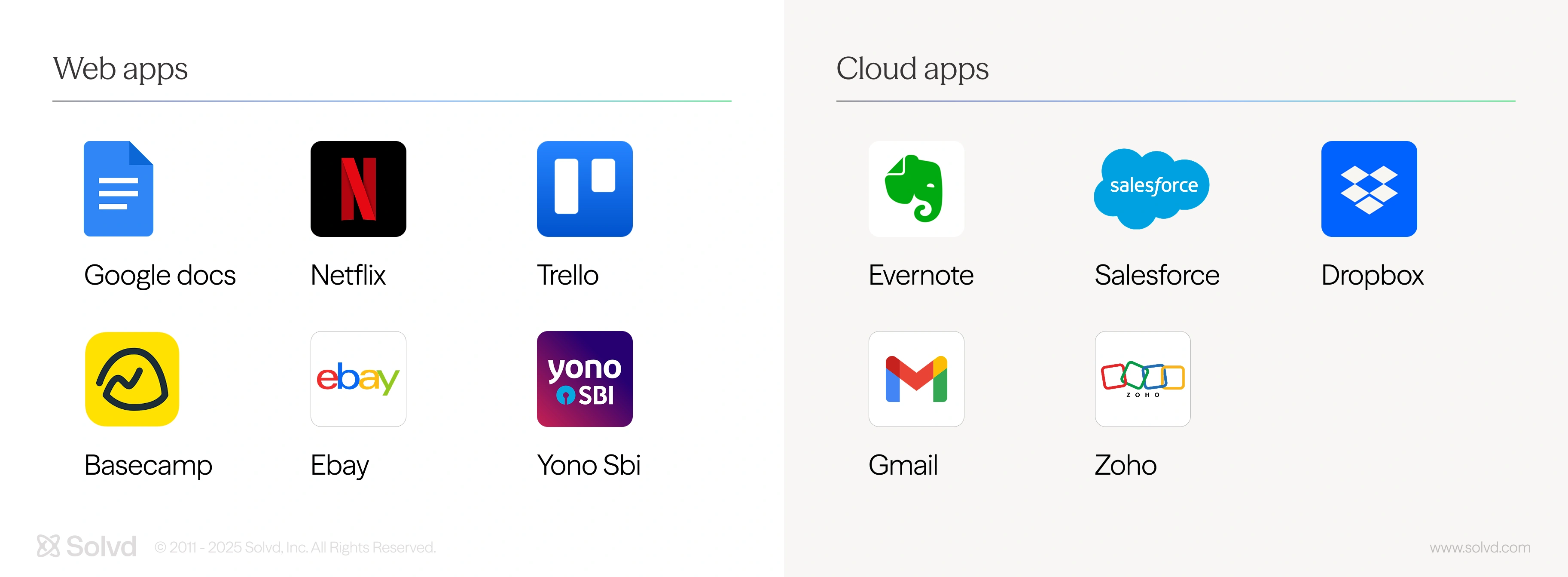In the digital age, our lives revolve around applications. But with so many options out there, choosing the right one can feel overwhelming. Have you ever wondered about the difference between web-based vs cloud-based apps? It’s a common question, and understanding the key distinctions can be a game-changer. This article dives deep into the world of web-based vs cloud-based applications. We will unpack their functionalities, accessibility, and demonstrate how they can empower your digital experience.
What is a web-based application?
Imagine a software program that lives on the internet and is accessible through any web browser like Chrome or Safari, (instead of being downloaded and installed on your computer like a traditional program). That’s essentially what a web application is, or web app for short.
Web apps run on the internet, so you can access them from any device that has a browser and an internet connection. This makes them super convenient and it saves space on your phone or computer.
Think of all those online tools you use daily, like email, social media, or online banking. Those are all web apps! They allow businesses to reach customers easily and provide services remotely.
You can also think of a photo editing program. Traditionally, you’d download and install it on your computer. A web app version lets you edit photos directly in your web browser without taking up any extra space on your device. This is similar to how a vending machine offers various snacks without the need for a separate machine for each individual item.
Types of web-based applications
| Type of Web App | Description | Examples |
|---|---|---|
| Static Web App | The simplest type, displays pre-written content, limited user interaction | Brochure website, online resume |
| Dynamic Web App | Generates content based on user input or server data, more interactive | Online banking app, social media platform |
| Single-Page App (SPA) | Loads all content in a single page, updates content without reloading | Gmail, Google Docs |
| Multi-Page App (MPA) | Traditional website structure, users navigate between separate pages | Most company websites, news websites |
| Progressive Web App (PWA) | Blurs the line between website and app, offers app-like features (offline access, push notifications) | Twitter Lite, Spotify web player |
| Content Management System (CMS) | Manages website content, allows easy updates without coding | WordPress, Wix |
| E-commerce Web App | Designed for online shopping, integrates product browsing, shopping cart, and checkout | Amazon, eBay |
| Portal Web App | Provides a central hub for accessing various information or services | University student portal, corporate intranet |
Benefits of web-based apps

Let’s delve into the key benefits that make web apps the go-to choice for individuals and businesses alike.
- Accessibility anywhere, anytime. Unlike software confined to a specific device, web apps are the ultimate digital nomads. With an internet connection and a web browser, you can access your data, tools, and functionalities from any device – laptop, phone, tablet – you name it. Imagine working on a document at the office, then you seamlessly pick up where you had left off on your phone during your commute home. Web apps break geographical barriers and they keep you connected to your work or projects.
- Cost-effective champion. Web apps offer significant cost savings for both businesses and individual users. Gone are the days of hefty software licenses and expensive upgrades. Since web apps reside on remote servers, there’s no need for you to purchase and install software on individual devices. This translates to reduced upfront costs and it eliminates the need for IT support for software installations across multiple machines.
- Effortless updates and maintenance. Say goodbye to the frustration of having to do software updates manually. With web apps, updates and bug fixes happen seamlessly on the server’s side. End users automatically receive the latest version without having to download or install anything. This not only streamlines the process but it also ensures that everyone is using the latest, most secure and feature-rich version of the application. Additionally, web apps typically require just minimal maintenance from the user’s end, which frees up IT resources and minimizes downtime from software conflicts.
- Collaboration made easy. Web apps are champions of teamwork. They provide a platform for real-time collaboration that allows multiple users to work on the same document or project simultaneously. This fosters better communication, increased productivity, and a unified workflow. Imagine a team brainstorming ideas on a shared whiteboard web app or multiple editors working on a document simultaneously.
- Enhanced scalability. Web apps are built to adapt. As your business grows or your personal needs change, web apps can easily scale to accommodate increased user loads and additional functionalities. Unlike traditional software that might require a complete overhaul, web apps can be readily modified and expanded on the server side. This scalability ensures that your web app can grow along with your needs, making it a future-proof investment.
- Security on the server side. Security is a top concern in today’s digital landscape. Web apps often benefit from robust security measures which have been implemented on the server side. Data is typically stored in secure data centers with advanced security protocols, firewalls, and encryption techniques. This centralized approach to security can be more reliable than counting on individual device security measures. Additionally, regular backups ensure data recovery in case of unforeseen circumstances.
- Integration powerhouse. The beauty of web apps lies in their ability to integrate seamlessly with other web services and applications. This allows you to connect your web app with other tools you use, which creates a powerful ecosystem that streamlines workflows and it eliminates the need for data re-entry. Imagine a CRM web app that integrates with your email marketing tool or an accounting web app that connects to your bank for automatic transactions. This level of integration empowers businesses to create a more unified and efficient work environment.
- Always available (almost). Web apps are designed to be highly available, which means they strive to be accessible 24/7 with minimal downtime. Regular server maintenance might cause brief interruptions, but overall, web apps offer a level of reliability that surpasses traditional software installations, which can be susceptible to device-specific issues. This high level of availability ensures that your crucial applications and data are always within reach, which helps to foster uninterrupted productivity.
What is a cloud-based application?
A cloud-based application, also referred to as a cloud application, is a software program that runs on a remote server that’s accessed over the internet rather than being installed on a local device. These applications are accessible from a variety of devices, such as computers, phones, and tablets. These devices have an internet connection and a web browser or a dedicated mobile app. In simpler terms, instead of downloading and installing software onto your computer, you access it remotely just like you would access a website. The software and your data are stored on remote servers managed by a cloud service provider.
Types of cloud-based apps
| Category | Description | Examples |
|---|---|---|
| By Service Delivery | This categorizes cloud applications based on what kind of service they provide. | |
| Software as a Service (SaaS) | Most common type. Ready-to-use applications accessed through a web browser or mobile app. | Gmail, Dropbox, Netflix, Zoom |
| Platform as a Service (PaaS) | Provides a platform for developers to build and deploy their own cloud applications. | Google App Engine, Microsoft Azure Platform, Amazon Web Services, Elastic, Beanstalk |
| Infrastructure as a Service (IaaS) | Offers virtualized computing resources like servers, storage, and networking. | Amazon EC2, Microsoft Azure Virtual Machines, Google Compute Engine |
| By Deployment Model | This categorizes cloud applications based on where they are hosted. | |
| Public Cloud | Applications hosted by a cloud service provider and accessible to the general public over the internet. | Most SaaS and PaaS applications |
| Private Cloud | Applications hosted on a dedicated cloud infrastructure for a single organization. | Provides potential for greater security and control over sensitive data |
| Hybrid Cloud | Combines both public and private cloud environments by optimizing workload and providing orchestration. | Offers flexibility and scalability for organizations with varying needs |
Benefits of cloud-based apps

Cloud apps offer numerous benefits that make them an attractive option for businesses and individuals alike. Let’s delve into some of the most significant advantages of using cloud-based applications:
- Enhanced accessibility and mobility. Cloud apps are very convenient. They are accessible from anywhere and at any time. All you need is just an internet connection and a web browser or mobile device. This eliminates the need to be chained to a specific computer or having to lug around heavy laptops. Imagine being able to edit documents on the go, review presentations while waiting at the airport, or access work files during a business trip – cloud apps make it all possible. This flexibility empowers remote workforces, fosters collaboration across geographical boundaries, and it ultimately boosts productivity.
- Scalability and cost-effectiveness. Traditional software often requires upfront licensing fees that can strain budgets (especially for small businesses). Cloud apps typically operate on a subscription model that allows users to pay based on their specific needs. This eliminates the need for hefty upfront investments and it allows users to scale their usage up or down as required. Need more storage for your growing photo collection? Simply upgrade your cloud storage plan. Have a seasonal dip in business activity? Easily scale back your cloud service usage without being penalized. Cloud apps offer a flexible and cost-effective approach to software management.
- Automatic updates and security. Keeping software updated with the latest security patches and features can be a time-consuming task. Cloud apps take care of this burden entirely. Updates are automatically deployed by the cloud service provider, which ensures that users always have access to the most secure and feature-rich version of the application. Cloud providers also invest heavily in robust security measures, including data encryption, access controls, and disaster recovery plans. This translates into a significant peace of mind for users who can trust that their data remains safe and secure.
- Integration and collaboration. Cloud apps often integrate seamlessly with other cloud-based services, which help create a unified and streamlined work environment. Imagine seamlessly transferring files between cloud storage and a document editing tool or collaborating on a project in real time with colleagues across the globe.
- Automatic backups and disaster recovery. Data loss can be a devastating setback for businesses and individuals alike. Cloud applications typically offer automatic backups that ensure your valuable data is constantly mirrored on remote servers. In case of a hardware failure or natural disaster, your data will stay safe and be readily accessible. This disaster recovery feature provides peace of mind and it ensures business continuity in the face of unforeseen events.
- Device independence. Cloud apps eliminate the need for powerful hardware and specific operating systems. It’s easy to access your applications because all you need is an internet connection and a compatible device. This opens up a world of possibilities, because it allows users to work from a variety of devices, from traditional laptops and desktops to tablets and smartphones. This flexibility caters to today’s mobile workforce and it allows users to work seamlessly across different devices.
- Environmentally friendly. Cloud computing offers a more eco-friendly alternative to traditional software installations. By utilizing shared resources in data centers, cloud applications reduce the need for individual hardware purchases and their associated energy consumption and waste generation.
Web-based vs cloud-based apps – key Differences
While the terms might seem interchangeable at first glance, there are key distinctions between web-based vs cloud-based apps. Understanding the following differences can help you choose the right tool for your project.
| Web-based apps | Cloud-based apps | |
|---|---|---|
| Application location and delivery | Reside on a specific web server owned and maintained by the developer or organization. Users access them solely through a web browser. | Run on remote servers managed by a cloud service provider (CSP) like Amazon Web Services (AWS) or Microsoft Azure. Users access them through web browsers or downloadable applications (desktop or mobile) that connect to the cloud service. |
| Data storage and security | Data might be stored on the same server as the application or across multiple locations, including cloud services. Security depends on the specific developer’s implementation. | Data is typically encrypted and stored in secure, geographically distributed data centers offered by the CSP. Cloud providers invest heavily in security measures to protect user data. |
| Scalability and flexibility | Scalability can be limited and require modern web hosting solutions. Adding more users or data might require the developer to upgrade the server infrastructure or redesign the architecture, which can be time-consuming and expensive. | Highly scalable. Cloud providers offer on-demand resources, allowing applications to easily scale up or down based on user needs. |
| Collaboration features | Collaboration capabilities might be limited and require additional development or integration. | Often designed with collaboration in mind. Features like real-time document editing, shared workspaces and file versioning facilitate seamless collaboration between users. |
| Offline functionality | Generally requires an internet connection to function. Some might offer limited offline functionality that allows users to perform specific tasks without internet access and syncing them later. | Some cloud-based apps offer offline functionality. Downloaded data allows users to work even without an internet connection, with changes syncing upon reconnection. |
| Software updates and maintenance | Developers are responsible for updating and maintaining the application. Users might experience downtime during updates. | The cloud provider can handle most of the updates and maintenance, ensuring users always have access to the latest version with minimal disruption. |
| Cost and deployment | Initial development costs might be lower, but ongoing maintenance and server infrastructure can be expensive, especially for large-scale applications. | Subscription-based model. Users pay a monthly or annual fee based on usage, eliminating the need for upfront infrastructure investment. |
| Customization | Customization options might be limited depending on the developer’s design. | Some cloud-based apps offer APIs that allow for custom integrations and functionalities. |

Choosing the right tool
The choice between a web-based vs cloud-based application depends on your specific needs. Consider factors like:
- Complexity of tasks. Simple tasks might be well-suited for web apps, while complex workflows benefit from the advanced features of cloud apps.
- Collaboration needs. If real-time collaboration is crucial, then cloud apps are the way to go.
- Offline access. For situations where internet connectivity is unreliable, choose a cloud app with offline functionality.
- Data security. If data security is a top priority, consider the provider’s track record and security practices before selecting a cloud app.
Conclusion
In conclusion, the battle between web-based vs cloud-based applications isn’t a duel but rather a nuanced choice based on your specific needs. Web-based applications offer a familiar and accessible experience, which are perfect for simple tasks and quick deployments. Cloud-based applications, on the other hand, provide a more scalable and feature-rich environment which is ideal for complex workflows and data storage.
Analysts predict continued growth for both web-based and cloud-based applications. However, according to Gartner, the cloud-based model is expected to become a business necessity by 2028 due to its inherent advantages such as scalability, security, and ease of access.
Regardless of your preference, Solvd can help you navigate the web-based vs cloud-based paradigm. Our expert web development team can craft a user-friendly web application, while our cloud management services can ensure a secure and scalable cloud-based solution. Contact us today to discuss your project with us and discover the perfect platform for your needs!
Frequently Asked Questions
Cloud services are like renting computing resources (storage, servers, software) over the internet and on demand. Web services are specific tools or functionalities that applications use to communicate and exchange data over the web. Think of cloud services as the infrastructure and web services as the tools that use it.
Web-based refers to something specifically designed to work in a web browser, while online simply means connected to the internet. So, all web-based applications are online, but not everything that’s online is web-based (like email or online banking).
A disadvantage of web-based apps is the need for reliance on an internet connection and adding offline capabilities for such applications can be challenging. The app becomes unusable if you lose your connection. Also, web-based apps might run slower than applications which have already been installed directly on your device.









